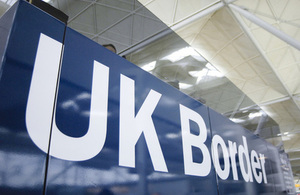Reports on unaccompanied asylum seeking children, right to rent and exit checks among those published
The Independent Chief Inspector of Borders and Immigration, David Bolt, has published no less than five new inspection reports today.
 Image credit: UK GovernmentThe 76-page report 'An inspection of how the Home Office considers the 'best interests' of unaccompanied asylum seeking children' is available from here.
Image credit: UK GovernmentThe 76-page report 'An inspection of how the Home Office considers the 'best interests' of unaccompanied asylum seeking children' is available from here.
In the report, Mr Bolt found that the Home Office needed to revisit most of the recommendations made in an earlier 2013 report and make improvements that stick.
"In addition, improvements are needed in relation to the National Transfer Scheme, in how the Home Office communicates with unaccompanied asylum seeking children and stakeholders, and in the use of UASC [Unaccompanied Asylum Seeking Children] leave. This report contains just 2 recommendations, although each breaks down into several parts. Overall, there is a considerable amount of work for the Home Office to do. Given the impact the asylum system has on the lives of those children and young people who come into contact with it, I hope that the Home Office can move quickly to make the necessary improvements," the Independent Chief Inspector added.
The 64-page second report, 'An inspection of the "Right to Rent" scheme', is available here.
Mr Bolt said: "This inspection looked at the Home Office’s development of the RtR scheme, its implementation and initial evaluation, the operational response by Immigration Compliance and Enforcement (ICE) teams and others, and what monitoring and evaluation there had been of RtR since it was rolled out across England. The report also summarises concerns from stakeholders about the impact of RtR on issues such as discrimination by landlords against particular groups or types of prospective tenants, exploitation and homelessness, but does not set out to examine and test these concerns thoroughly.
"Overall, I found that the Right to Rent scheme had yet to demonstrate its worth as a tool to encourage immigration compliance, with the Home Office failing to coordinate, maximise or even measure effectively its use, while at the same time doing little to address the concerns of stakeholders. My report contains 4 recommendations, all of which point to the need for more grip and urgency."
The third report - 'A re-inspection of Border Force's identification and treatment of Potential Victims of Modern Slavery' - is here.
The re-inspection found that Border Force had done a considerable amount of work towards implementing the recommendations in the Independent Chief Inspector's original February 2017 inspection report.
"This re-inspection report makes no new recommendations, but in the case of 5 of the original recommendations, particularly those focused on improving record keeping and data collection, there was insufficient evidence that the work that had been done had been effective, and some improvements that were in train needed speeding up. These 5 recommendations therefore remain 'open'," the Independent Chief Inspector said.
The 56-page 'An Inspection of Border Force operations at Stansted Airport' can be downloaded from here.
The Independent Chief Inspector said: "During this inspection, as is customary, inspectors spent time at Stansted observing Border Force in action, and interviewing and holding focus groups with staff. The report reflects their views as expressed. It also reflects the views of Border Force management, informed inter alia by the results of the most recent (2017) People Survey. It is fair to say that these views differ substantially on some key points.
"Whether the People Survey results are a more reliable indicator of staff engagement than the views expressed to inspectors, which is Border Force's contention given that two-thirds of Stansted staff responded to the Survey, the comments made to inspectors point to the fact that Border Force management has more to do to connect with some members of its Stansted team. The report contains 9 recommendations for improvement. Those in relation to communication and the provision of training are most relevant in terms of further improving staff engagement at Stansted."
Finally, the 56-page report 'An inspection of exit checks' is accessible from here.
Mr Bolt found: "Overall, the sense was that the Home Office had over-promised when setting out its plans for exit checks, and then closed the Exit Check Programme prematurely, declaring exit checks to be "business as usual" when a significant amount of work remained to be done to get full value from them.
"This work needed better coordination within the Home Office, and externally with carriers, with other potential contributors to and users of the data, and with Common Travel Area partners. In the meantime, the Home Office needed to be more careful about presenting exit checks as the answer to managing the illegal migrant population, which for now remained wishful thinking.
"My report contains one overarching recommendation: that the Home Office re-establishes the Exit Checks Programme, with appropriate Programme oversight, governance and documentation, in order to drive the improvements needed in data quality and completeness and to coordinate and encourage its effective operational use. There was also a need to refresh and restate the 'vision' for exit checks, and reset expectations."
The Home Office's reports to the reports are available from here.